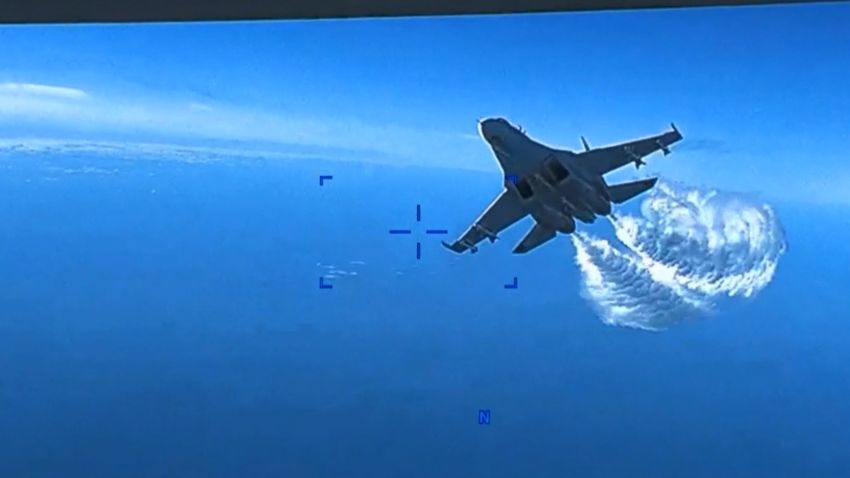Editor’s Note: Sébastien Roblin has written on the technical, historical and political aspects of international security and conflict for outlets including 19FortyFive, Popular Mechanics, The National Interest, NBC, Forbes.com, Inside Unmanned Systems and War is Boring. He holds a master’s degree from Georgetown University in conflict resolution and served with the Peace Corps in China. He tweets @sebastienroblin. The opinions expressed in this commentary are solely those of the author. View more opinion on CNN.
For 30 to 40 minutes in international airspace over the Black Sea on Tuesday morning local time, two Russian fighter jets harried a slow-moving American surveillance drone by flying dangerously close to it and dumping fuel over it, according to the US military.

Things came to an end only when one of Russia’s Su-27 ‘Flanker’ planes reportedly collided with the propeller on the drone’s tail, causing the MQ-9 Reaper drone to crash into the sea. It was the first time the countries’ military aircraft made direct physical contact since the start of the Ukraine war last year.
A video released by the US military Thursday shows the aggressive fuel dumping maneuver, as well as the approach of an Su-27 jet that seems likely to have clipped the drone. Subsequent footage shows impact damage to the propeller. The video further eroded the credibility of Moscow’s denial that any collision took place.
The Russian jets’ activities were bullying, pure and simple — at best an attempt to muscle aircraft out of airspace that’s open to all, if not outright destroy it. Some are tempted to advocate a response in kind to punish Russia for this episode, including Sen. Lindsay Graham (R-SC), who recently said on Fox News the US should threaten that any future Russian aircraft approaching those of the US military would be “shot down.”
But Washington shouldn’t stoop to Moscow’s level. The best reaction to schoolyard bullying is to show you aren’t rattled by provocations, and this arena is no different.
That doesn’t mean the US should stop its surveillance flights, both manned and unmanned, over this (and other) international airspace. In fact, it’s essential that the US continue its missions unabated. But an excessively dramatic American reaction could destabilize the current norms surrounding such flights and lead to a tit-for-tat spiral with the Kremlin that could escalate unpredictably.
That’s something to be avoided unless absolutely essential — particularly because at present these surveillance flights are giving the US valuable intelligence. Russia’s military has already been paying a price pretty much daily thanks to the intelligence collection activities of MQ-9 drones and other systems.
It would be counterproductive to jeopardize that with a heated response to Russia’s bad behavior, something that remains true even though this incident is far from isolated and encounters such as these are likely to increase.
In October, the UK said that a Russian Su-27 tailing a British RC-135W plane over the Black Sea fired a missile nearby (Russia said it was an accident). Fortunately no damage was done. In 2016, Russian bombers buzzed dangerously low over the US destroyer Donald Cook while it was on patrol in the Black Sea. And there was even a 2019 incident where a Russian warship intentionally came within 50 feet of colliding with the USS Chancellorsville, per the US military. Overall, since Russia’s invasion of Crimea in 2014 and the subsequent Western backlash, such encounters have multiplied in frequency.
It’s worth unpacking which surveillance encounters violate common norms and which don’t. Rival militaries that are not at war routinely shadow each other’s activities and intercept each other’s aircraft and ships — in other words, send fast planes and vessels to come within close visual range of their adversaries’ craft to show they’re being watched and kept at bay. It’s legal under international law and generally perceived as acceptable over international waters so long as neither side performs maneuvers dangerously close to the other.
Russian pilots often practice safe intercepts in more routine encounters, as do American pilots. But a 2022 study by the Rand Corporation found that Russian pilots were apparently ordered to conduct unsafe intercepts to try to drive away foreign forces near areas they consider sensitive.
Undoubtedly at the heart of Russia’s aggressive intercept Tuesday was the drone’s gathering of intelligence that could be used to assist Ukraine’s military. But galling as that may be for Moscow, the US and Russia haven’t declared war against each other, and physical attacks on the other’s military in international waters and airspace remain illegal except in self-defense against direct, imminent attack.
What most likely happened on Tuesday is that the Russian pilots were instructed to seriously harass the drone, and pilot error then resulted in an unplanned collision. As for Russia’s complaints that the drone turned off its transponders (which makes it possible to identify the aircraft at a distance), the fighters interacted with the drone for more than a half hour; it’s hardly believable that they didn’t know it was American — and if they thought it was Ukrainian, they would have almost certainly shot it down.
Russia would like to pretend the Black Sea is its personal pond, but these are international waters bordered by Bulgaria, Georgia, Romania and Turkey as well — all but one are NATO members. The rules surrounding international waters and airspace are clear: National sovereignty extends no further than 12 nautical miles from the nearest coastline or border. If Russia wants to dispatch nuclear-capable bombers just farther than 12 nautical miles off the coast of Alaska, it can and has done so without major incident.
In the current case, Russia is insisting the drone was in an exclusion zone it asserted around Ukraine for its “special military operation” (i.e. a full-fledged war of conquest). While countries claim all kinds of additional jurisdictions like exclusive economic zones and air defense identification zones, the 12 nautical mile rule is the only one that has indisputable weight internationally.
In the current case, the US has responded so far by dressing down the Russian ambassador over the incident. The Pentagon might also decide to send manned fighters to escort drones to dissuade harassment. But this is something that couldn’t be sustained indefinitely; the point of drones is they’re generally much less costly per hour to operate than fighters and put personnel at less risk. Alternatively, the drones could be armed with their own air-to-air missiles.
Either way, the impact would be mostly psychological because US aircraft are unlikely to be authorized to shoot at Russian warplanes merely for performing dangerous maneuvers. The ethics of attacks on drones constitute a Wild West since the expansion of their technology has been so rapid. But since their destruction rightly lacks the moral weight of an attack on a manned craft, it makes sense not to treat the downing of an individual drone as a casus belli — which is what the Trump administration assessed in 2019 when it cancelled a retaliatory strike after Iran downed a US drone.
A sustained, deliberate pattern of destructive Russian attacks on drones would merit a response, but that’s not the case with the Black Sea collision — yet. For now, the US can and should confidently continue to occupy the high ground from a position of strength, defending a mutual norm which gives the United States, its allies and even its enemies transparency regarding each other’s military actions.





